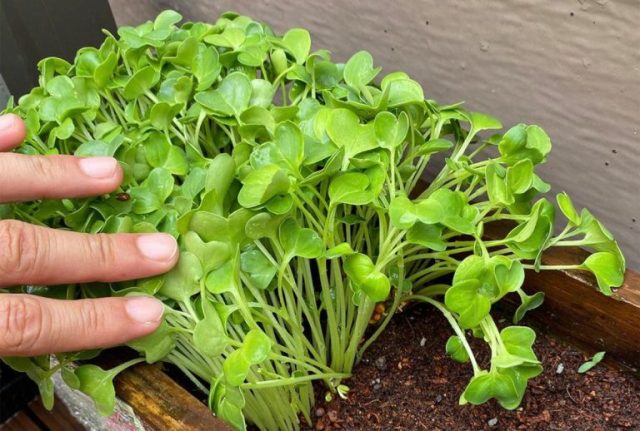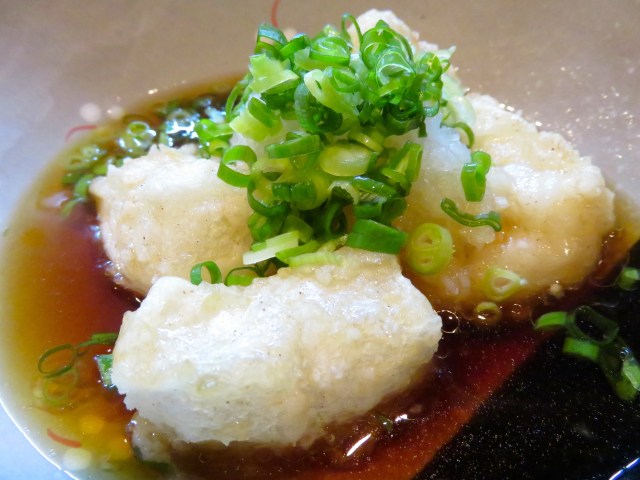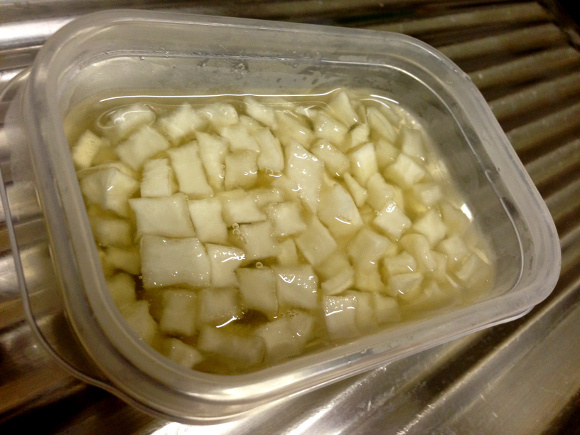We sample the local specialty bread (or something like it?) that Shiga is famous for (and at least don’t pan-ic in the process).
daikon
A cross-cultural conversation helps Seiji rediscover one of his favorite dishes from his childhood.
People in Japan are going crazy for this dish and the best thing about it is you can make it at home too!
Vegetarians traveling to Japan may find it difficult to find food that fits their dietary lifestyle. Fish seems to be in everything including the soup stock used to make miso soup. To make matters worse, many foods in convenience stores, bakeries or even Starbucks have misleading labels, and that “vegetable sandwich,” or “vegetable pizza” may actually have meat in it too! You can order foods like okonomiyaki or monjayaki with no meat, but you still can’t be sure it won’t come with shredded fish flakes on top that there isn’t fish lurking in the dashi-based sauces.
I always recommend to my vegetarian friends that rather than asking Japanese restaurants to make something special for them, it’s better to just order food that doesn’t have fish or meat (or dairy) in it from the beginning. Fish has always been a staple in the Japanese diet, but the eating of wild and domestic game was banned for over 1,200 years in Japan, and Buddhist tradition gave rise to a special vegetarian cuisine called shojin ryori. Even now, the traditional Buddhist meal called ozen (rice, miso soup, pickles, boiled/simmered vegetables and beans), is still served at funerals in Japan.
So traditionally, there is a lot of vegetarian food in the Japanese diet. You just have to discover it. And RocketNews24 is here to help! In this article we’ll introduce you to common Japanese dishes that can be ordered at almost any Japanese restaurant that have no meat, fish or animal products in them, so, let’s jump into Japanese vegetarianism 101.
Daikon is one of the cornerstones of Japanese cuisine. It has a firm yet yielding texture and ability to meld with any flavors it comes in contact with such as oden broth. However, most ways of eating daikon involve cooking which largely squanders the precious vitamin C that it contains.
You could eat it raw, but on its own daikon has a bitter and bland flavor suitable for no one. At least, it did until now thanks to a recipe posted on Cookpad, Japan’s premier recipe site, by a user with the handle of ayureo. This recipe is certifiably delicious, cheap, and so simple that anyone can do it — even us!
Summer is here and with it come the sleepless nights of rolling around in bed searching for a sweat-free spot. Of course, fans and air conditioners are at hand but they bring a whole other set of problems such as dry, sore throats in the morning and incessant buzzing that might make it even harder to nod off.
They say summer colds are the worst kind, and taking standard medicine with all the drowsiness they can cause is no good in this already delirium-inducing heat.
Now, we don’t promise this to be a cure (it’s a common cold, after all!), but for those suffering from summer sniffles and phlegm we humbly recommend a simple recipe using all natural ingredients: honey, daikon, and just a pinch of patience.
If you’ve been keeping up with the amazing 3-D latte art trends going on in Japan’s barista world right now, then you might want to take a look at their savoury counterparts popping up in grated radish form. Instead of swimming in cups of coffee, these adorable home-made creations are taking dips in winter hot pots and stews. Join us as we take a look at some of the cutest critters on offer, from Ghibli characters to sleeping cats, and see just how easy it is to cook up some edible cuteness at home.
Daikon radishes have been really stepping up their game lately and upping the cuteness to a solid 11. First, we saw these adorable mounds of grated daikon capybaras swimming in soup. Now, a little old lady has grown a daikon that bears a striking resemblance to a Pokemon character. More on where the little guy was found and how it came to be after the break!
Japan’s premier recipe website, Cookpad, is an excellent resource for those looking to make some clever home cooking along with seasonal treats and some more unorthodox creations like #c0ffee.
One little gem of a recipe that’s been getting some high praise is Setsunai… Daikon Oroshi Daruma (Wistful… Grated Daikon Daruma). Although named after the round and red lucky charms of Japan, these side dishes certainly resemble snowmen, or yuki daruma in Japanese.
Daikon is one of the most well-known of the Japanese vegetables. Essentially an enormous radish, daikon are primarily used for pickling and seasoning, though you can find their leaves in some dishes as well. Although the kinds of radish known to Westerners tend to have a strong “bite” to them, Japanese daikon is much milder, and a firm favorite at this time of year found in warming dishes like oden.
Since daikon is used in so much food in Japan, it’s a very familiar taste for most Japanese people, and you can find it in everything from traditional cuisine to otsumami (snacks eaten while drinking), when people sometimes eat large chunks of boiled daikon. Despite what you might think, it’s surprisingly tasty! But what about making wine from daikon?
With the unveiling of the next iteration of iPhones, the iPhone 5S and the iPhone 5C a lot has been said about the iPhone 5C’s official protective case. I won’t bore you with all the details, but the words “aesthetic train wreck” tend to get bandied about.
People in Japan, however, get it very much. They see the brilliant functionality that helps them with a daily chore which an app could never fulfill. It helps them garnish their dishes with grated daikon, for instance…
The noble daikon is a beloved vegetable of Japan with a wide range of culinary uses along with other uses like carving huge phalluses, making cute calendars, or avant-garde musical instruments.
However, during two days in December of last year 100 daikon were mercilessly snatched from their homes and brutally crushed in Suzuka City, Mie Prefecture.
After a tireless investigation the police announced on 22 April that the culprits have been apprehended. The ringleader was an unnamed 14 year-old junior high school girl with a very strange motive indeed…
















 Majority of Japanese mayors say foreign residents are essential but most see good and bad effects
Majority of Japanese mayors say foreign residents are essential but most see good and bad effects Japanese beef bowl chain Sukiya’s 2026 Smile Box lucky bag basically pays for itself
Japanese beef bowl chain Sukiya’s 2026 Smile Box lucky bag basically pays for itself Dedicate your savings to your oshi of choice with this new buildable offertory box
Dedicate your savings to your oshi of choice with this new buildable offertory box Survey asks Japanese teens which school club they want to join, and “kitaku” club is top choice
Survey asks Japanese teens which school club they want to join, and “kitaku” club is top choice Japanese toilet sweets put a new twist on tradition
Japanese toilet sweets put a new twist on tradition New Studio Ghibli collection includes a US$2,450 wooden Totoro 【Video】
New Studio Ghibli collection includes a US$2,450 wooden Totoro 【Video】 Pizza Hut Japan’s hot lucky bags are perfect for a New Year’s pizza party
Pizza Hut Japan’s hot lucky bags are perfect for a New Year’s pizza party Japan’s first hotel with a human washing machine is now ready for you to come and bathe in it
Japan’s first hotel with a human washing machine is now ready for you to come and bathe in it Green tea chocolate-covered potato chips arrive in Japan! 【Taste test】
Green tea chocolate-covered potato chips arrive in Japan! 【Taste test】 Japan now has potato chip-covered chocolate, and it’s amazing!【Taste test】
Japan now has potato chip-covered chocolate, and it’s amazing!【Taste test】 Starbucks Japan ready to get Year of the Horse started with adorable drinkware and plushies【Pics】
Starbucks Japan ready to get Year of the Horse started with adorable drinkware and plushies【Pics】 Hayao Miyazaki says Happy New Year to Studio Ghibli fans with new art for Year of the Horse
Hayao Miyazaki says Happy New Year to Studio Ghibli fans with new art for Year of the Horse We found possibly the quietest Japanese-style hotel in Tokyo’s bustling Shinjuku district
We found possibly the quietest Japanese-style hotel in Tokyo’s bustling Shinjuku district Cup Noodle tries an authentic Jiro-style ramen, but something’s not quite right
Cup Noodle tries an authentic Jiro-style ramen, but something’s not quite right The best Starbucks Japan Frappuccinos we want to drink again in 2026
The best Starbucks Japan Frappuccinos we want to drink again in 2026 We revisited Sweets Paradise after a decade to see if Japan’s dessert buffet still delivers
We revisited Sweets Paradise after a decade to see if Japan’s dessert buffet still delivers That time Seiji called JASRAC to ask why he didn’t get paid royalties for his song being on TV
That time Seiji called JASRAC to ask why he didn’t get paid royalties for his song being on TV Japan’s oldest largetooth sawfish in captivity back on display in Mie Prefecture
Japan’s oldest largetooth sawfish in captivity back on display in Mie Prefecture 7-Eleven Japan starts new temporary luggage storage service in over 300 branches
7-Eleven Japan starts new temporary luggage storage service in over 300 branches Disillusionment at Tsukiji’s tourist-target prices led us to a great ramen restaurant in Tokyo
Disillusionment at Tsukiji’s tourist-target prices led us to a great ramen restaurant in Tokyo Starbucks teams up with 166-year-old Kyoto doll maker for Year of the Horse decorations【Photos】
Starbucks teams up with 166-year-old Kyoto doll maker for Year of the Horse decorations【Photos】 Tokyo considering law requiring more trash cans following litter increase in heavily touristed area
Tokyo considering law requiring more trash cans following litter increase in heavily touristed area Tokyo’s Tsukiji sushi neighborhood asks tour groups to stay away for the rest of the month
Tokyo’s Tsukiji sushi neighborhood asks tour groups to stay away for the rest of the month Tokyo event lets you travel back in time, for free, to celebrate 100 years since Showa era start
Tokyo event lets you travel back in time, for free, to celebrate 100 years since Showa era start Japan may add Japanese language proficiency, lifestyle classes to permanent foreign resident requirements
Japan may add Japanese language proficiency, lifestyle classes to permanent foreign resident requirements Sanrio theme park in Japan announces plans to expand into a Sanrio resort
Sanrio theme park in Japan announces plans to expand into a Sanrio resort Stamina-destroying “Paralysis Noodles” are Tokyo’s newest over-the-top ramen innovation
Stamina-destroying “Paralysis Noodles” are Tokyo’s newest over-the-top ramen innovation Survey asks foreign tourists what bothered them in Japan, more than half gave same answer
Survey asks foreign tourists what bothered them in Japan, more than half gave same answer Japan’s human washing machines will go on sale to general public, demos to be held in Tokyo
Japan’s human washing machines will go on sale to general public, demos to be held in Tokyo Japan’s deadliest food claims more victims, but why do people keep eating it for New Year’s?
Japan’s deadliest food claims more victims, but why do people keep eating it for New Year’s? We deeply regret going into this tunnel on our walk in the mountains of Japan
We deeply regret going into this tunnel on our walk in the mountains of Japan Studio Ghibli releases Kodama forest spirits from Princess Mononoke to light up your home
Studio Ghibli releases Kodama forest spirits from Princess Mononoke to light up your home Major Japanese hotel chain says reservations via overseas booking sites may not be valid
Major Japanese hotel chain says reservations via overseas booking sites may not be valid Put sesame oil in your coffee? Japanese maker says it’s the best way to start your day【Taste test】
Put sesame oil in your coffee? Japanese maker says it’s the best way to start your day【Taste test】 No more using real katana for tourism activities, Japan’s National Police Agency says
No more using real katana for tourism activities, Japan’s National Police Agency says Starbucks Japan reveals new sakura drinkware collection, inspired by evening cherry blossoms
Starbucks Japan reveals new sakura drinkware collection, inspired by evening cherry blossoms Updated cherry blossom forecast shows extra-long sakura season for Japan this year
Updated cherry blossom forecast shows extra-long sakura season for Japan this year New Studio Ghibli collection includes a US$2,450 wooden Totoro 【Video】
New Studio Ghibli collection includes a US$2,450 wooden Totoro 【Video】 Pizza Hut Japan’s hot lucky bags are perfect for a New Year’s pizza party
Pizza Hut Japan’s hot lucky bags are perfect for a New Year’s pizza party Japan’s first hotel with a human washing machine is now ready for you to come and bathe in it
Japan’s first hotel with a human washing machine is now ready for you to come and bathe in it Green tea chocolate-covered potato chips arrive in Japan! 【Taste test】
Green tea chocolate-covered potato chips arrive in Japan! 【Taste test】 Japan now has potato chip-covered chocolate, and it’s amazing!【Taste test】
Japan now has potato chip-covered chocolate, and it’s amazing!【Taste test】 Godzilla-shaped ice cream on sale in Tokyo near the sight his most adorable rampage
Godzilla-shaped ice cream on sale in Tokyo near the sight his most adorable rampage Real-life Spirited Away train line found in Japan?
Real-life Spirited Away train line found in Japan? Japanese government considering raising foreign resident visa renewal fees by 400 percent or more
Japanese government considering raising foreign resident visa renewal fees by 400 percent or more Robot noodle chef starts working in Tokyo train station, serves up taste of the future【Video】
Robot noodle chef starts working in Tokyo train station, serves up taste of the future【Video】 KFC Japan introduces a new burger 8 years in the making
KFC Japan introduces a new burger 8 years in the making Google ad wins praise for touching on troubled history of India and Pakistan
Google ad wins praise for touching on troubled history of India and Pakistan Famous manga artist gives out advice on how to draw breasts to celebrate Boob Day
Famous manga artist gives out advice on how to draw breasts to celebrate Boob Day